
Chubut is a province in southern Argentina, situated between the 42nd parallel south, the 46th parallel south, the Andes range to the west, and the Atlantic Ocean to the east. The province's name derives from the Tehuelche word chupat, meaning "transparent", their description of the Chubut River.
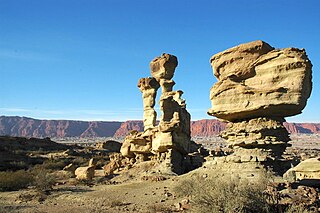
San Juan Province is a province of Argentina, located in the western part of the country. Neighbouring provinces are, moving clockwise from the north, La Rioja, San Luis and Mendoza. It borders with Chile to the west.
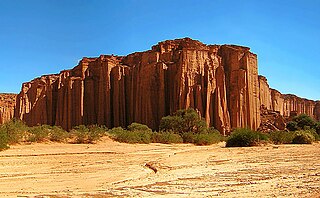
La Rioja, officially Province of La Rioja is a province of Argentina located in the west of the country. The landscape of the province consist of a series of arid to semi-arid mountain ranges and agricultural valleys in between. It is in one of these valleys that the capital of the province, the city of La Rioja, lies. Neighboring provinces are, from the north clockwise, Catamarca, Córdoba, San Luis and San Juan. The Triassic sauropodomorph dinosaur Riojasaurus is named after the province.

Misiones is a department located in the southern region of Paraguay. Its capital is San Juan Bautista. The eighth of Paraguay's 17 departments, it was created in 1906, then known as the San Ignacio Department, and was not given its present name until 1945. Its current name reflects its status as home to several Jesuit Reductions, or missions.
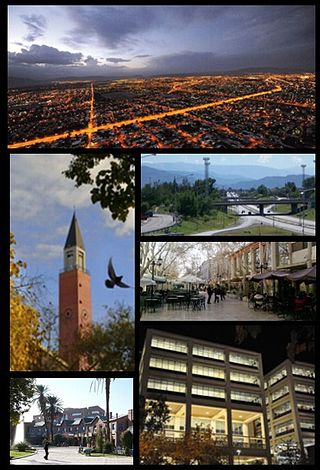
San Juan is the capital and largest city of the Argentine province of San Juan in the Cuyo region, located in the Tulúm Valley, west of the San Juan River, at 650 m (2,133 ft) above mean sea level, with a population of around 112,000 as per the 2001 census [INDEC].

The following is an alphabetical list of topics related to the Argentina.

National Route 40, also known as RN40 or "Ruta 40", is a route in western Argentina, stretching from Cabo Vírgenes near Río Gallegos in Santa Cruz Province in the south to La Quiaca in Jujuy Province in the north with approximately 5194 km length. The route parallels the Andes mountains. The southern part of the route, by now largely paved, has become a well-known adventure tourism journey, and there are plans to pave the whole road.
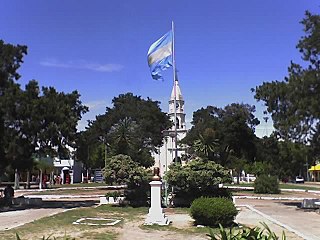
Merlo is the head city of the eponymous partido of Merlo and seat of the municipal government, located in the Greater Buenos Aires urban area of Buenos Aires Province, Argentina.
Caseros is a city in Buenos Aires Province, Argentina. It is the head town of the Tres de Febrero Partido which forms part of the Greater Buenos Aires urban conurbation.

Nueve de Julio is a department of Argentina, located in the south-center of the province of San Juan. Lying within the Tulum Valley agricultural oasis, almost 80% of the department's area is cultivated; it is known in particular for its production of wine and its fruit and vegetable crops.

Iglesia is a department of the province of San Juan, Argentina. It is located in the northwest mountainous corner of this province with substantial vegetation. Iglesia is one of the most visited departments in the province, particularly around Rodeo.

Cumbre de la Majadita is a mountain peak in the province of San Juan in Argentina near the town of Rodeo. It was one of the last 6000m+ peaks in the Andes to be climbed, the first recorded ascent being in December 1996.
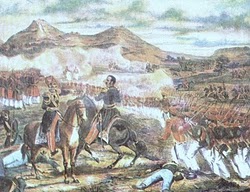
The Battle of Famaillá, was a Federal Party victory, under the command of former Uruguayan president Manuel Oribe, over the army of the Unitarian Party under general Juan Lavalle, during the Argentine Civil War.
National Route 18 is an Argentine paved highway, which crosses the province of Entre Ríos from west to east. Beginning in San Benito, a few km east of Paraná, at km 451 of National Route 12, it ends 25 km southwest of Concordia, at km. 240 of National Route 14. Its route is 227 km. It has been in the process of being transformed into a highway since 2015.

San Guillermo National Park is a national park in Argentina, in the Iglesia Department of San Juan Province. It was established in 1998 and is part of the San Guillermo Biosphere Reserve. Elevations in the biosphere range from 2,100 metres (6,900 ft) to 6,380 metres (20,930 ft). Vegetation in the National Park and biosphere consists of barren desert, grasslands, and a few wetlands, all located in the high, arid Andes. The animals include vicuña, guanaco, culpeo fox, Andean mountain cat, cougar, and Andean condor.
Ombúes de Lavalle is a small city located in the north of Colonia Department in southwestern Uruguay. It is named after the Argentine General Juan Lavalle. The term «Ombúes» is the Spanish plural for «Ombú», a tree originary of the Pampas region, in southern South America, and a national symbol of both Argentina and Uruguay.

Leyesaurus is an extinct genus of massospondylid sauropodomorph dinosaur known from the San Juan Province, northwestern Argentina.

José Nazario Benavídez was an Argentine soldier who rose to the rank of Brigadier General and played a leading role in the Argentine Civil Wars. He was Governor of San Juan Province, Argentina, for almost twenty years in the mid-nineteenth century. His lengthy political career during a period of great turbulence was due to the great respect in which he was held by enemies as well as friends. After leaving office he was imprisoned and then murdered by his guards.
The Battle of Rodeo del Medio, fought in Mendoza Province, Argentina on 24 September 1841, took place between the Federalist army of Ángel Pacheco and the Unitarian army of Gregorio Aráoz de Lamadrid during the Argentine Civil Wars. The consequences of the Federalist victory would last for a decade.

Emilio Conesa (1821-1873) was an Argentine military figure who was notable for his service being described as outstanding in the Argentine Civil Wars and in the Paraguayan War.

















